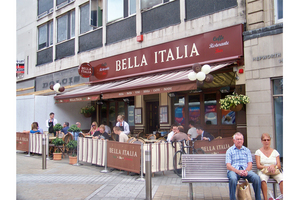In the last decade, the Atkins low carb diet exploded in popularity, soon to be followed by numerous other diets that also stress reducing carbs as one of their key components. By now virtually all dieters are familiar with low carb diets, and many have been on one in the past or are currently on one.
So many of the most common foods are high in carbs, though, that it can be a challenge to stick to such a diet. It is especially tough when eating out, and some would say tougher still when eating in an Italian restaurant specifically, given the abundance of carbs in bread, pizza, pasta, and so many mainstays of Italian meals.
Yet with a little forethought and discipline, it’s quite possible to keep your intake of carbs low, even in an Italian restaurant. Here are a few tips to help you do so:
* Much of the antipasto that is typically served before your meal is perfectly fine for a low carb diet. Salami, vegetables, shrimp and other seafood, etc. are all low carb foods. Many cheeses are low in carbs.
* Soups vary a great deal in carbs, but certainly there are some that are served in Italian restaurants that are fairly low in carbs. Thinner, brothy soups and soups with a lot of vegetables tend to be lower in carbs, while cream soups or soups that contain a lot of bread or noodles should be avoided.
* Salads are generally a very good choice. Just stay away from some of the toppings, like croutons or high fat salad dressings.
* One of the highlights for many people of a trip to an Italian restaurant is the bowl of assorted fresh breads. Unfortunately you’ll want to skip that, or at most sample from it only lightly. That basket is loaded with carbs.
* Similarly, you’ll certainly want to steer clear of pizza.
* Pasta is a high carb food generally, so it is best avoided as well. Not all pasta is equally bad though. You’re better off with whole wheat than regular pasta, if the restaurant has it. And you’re better off with pasta cooked al dente to retain its firmness rather than cooked otherwise, as this lowers the glycemic index of the pasta, which some believe lowers the amount of carbohydrates digested and absorbed into the body.
Still, these options aren’t as good for a low carb diet as simply skipping the pasta.
By the way, a lot of times what people really crave about the pasta dish is the sauce or cheese or other toppings, and those are often fine for a low carb diet. Tomato-based sauces tend to be low carb for instance, unless they are of a commercial brand with a lot of added sugar. So consider ordering those low carb toppings you like on meat or vegetables instead of on pasta.
* Though one’s first thought might be that if you eliminate pizza and pasta as choices you’ve pretty well eliminated the point of going to an Italian restaurant in the first place, that’s actually not true. In addition to low carb appetizers, salads, and soups, Italian restaurants serve many entrees that are low in carbs as well, such as many chicken, seafood, or veal dishes.
Meatballs are iffy. They don’t have a lot of carbs, but if they’re made with bread crumbs they will have more than most meats.
* Some common appetizers and entrees served in Italian restaurants, such as fried calamari, may be breaded, and of course that means lots of carbs. If you’re not sure if a menu item is breaded, just ask.
* Dessert in an Italian restaurant can be very good for a low carb diet, e.g., fresh fruit, or very bad for a low carb diet, e.g., tiramisu or almost everything else.
As you can see, with the options available in an Italian restaurant, you can easily have anything from a very high carb meal to a very low carb meal. Make the right choices and you should be able to stick with whatever level of carbs your particular diet calls for.
Sources:
Laura Dolson, “Low-Carb Eating in Italian Restaurants.” About.com.
Cathy Leman, “Mediterranean, Italian, Middle Eastern, and Mexican Restaurants.” TLC.
